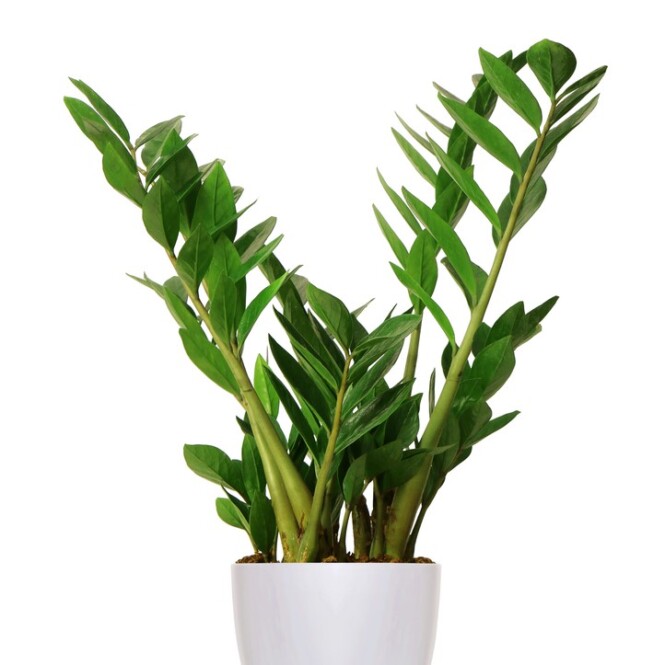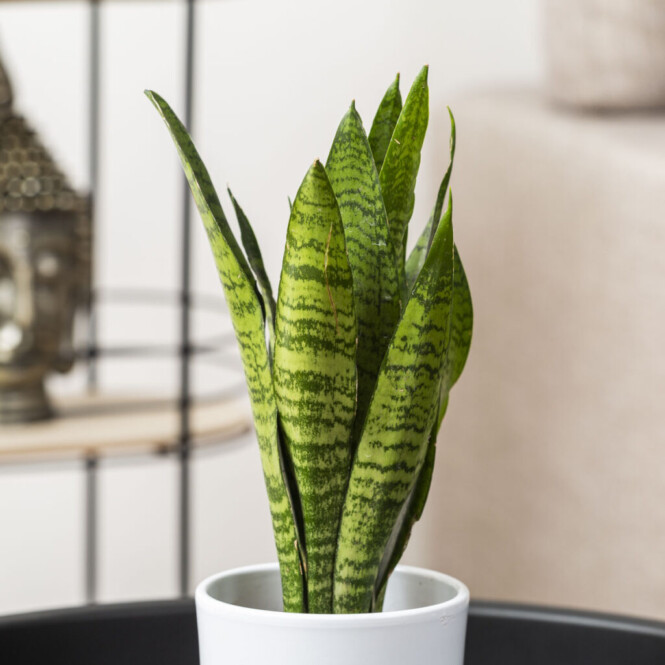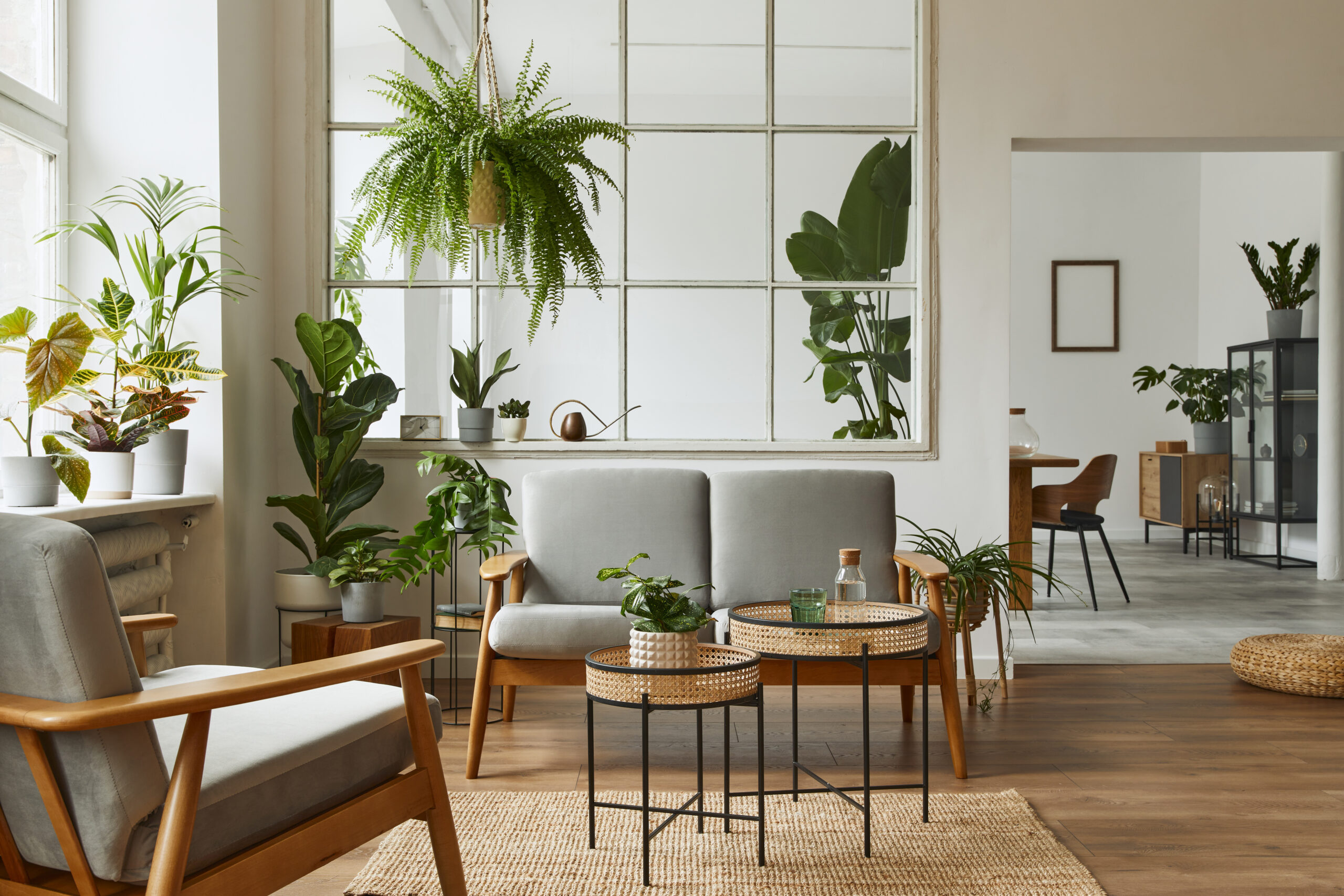
Benefits of indoor plants
Indoor plants offer a wide range of benefits, making them a popular choice for home and office environments. Living in a healthy and peaceful environment can be beneficial to your overall wellness by reducing stress and improving air quality. Here are some of the key advantages of having indoor plants.
Improved air quality
Indoor plants help purify the air by absorbing carbon dioxide and releasing oxygen during photosynthesis. They also remove toxins and pollutants from the air, making it fresher and healthier to breathe. Modern furnishings, synthetic building materials, and even your own carpet may carry chemicals which can make up to 90 percent of indoor air pollution. Household chemicals come from objects and materials like:
- carpets
- glues
- ovens
- cleaning solutions
- synthetic materials such as plastic, fiber, and rubber
Natural humidity regulation
Many indoor plants release moisture through a process called transpiration, which can help maintain optimal indoor humidity levels. This is especially beneficial in dry, indoor environments or during the winter months when heating systems can dry out the air. This can be particularly helpful in preventing dry skin and respiratory issues.
Enhanced mood and well-being
Being around indoor plants can have a positive impact on mental health. Studies have shown that they can reduce stress, anxiety, and depression while promoting feelings of calm and relaxation.
Increased productivity
Indoor plants can improve concentration and focus, leading to increased productivity in work or study environments. They create a more pleasant and visually appealing atmosphere that can boost motivation. Being stuck in an office or other small space for hours at a time can feel overbearing. Studies have found that less than 20 minutes is enough to make us feel more at peace.
Aesthetic appeal
Indoor plants can enhance the aesthetics of any space. They come in various shapes, sizes, and colors, allowing you to decorate your home or office in a way that suits your personal style.
Noise reduction
Some indoor plants, particularly those with large, dense foliage, can help absorb and muffle sound, reducing noise levels in indoor spaces.
Health benefits
Studies have suggested that indoor plants can help lower blood pressure and reduce the frequency of headaches and other health issues. The presence of greenery can promote overall well-being. According to a 1989 NASA study, houseplants can help improve air quality by removing cancer-causing chemicals like formaldehyde and benzene from the air. NASA recommends two or three plants for every 100 square feet/ 9 square meters. A 2015 study found that caring for indoor plants reduced psychological and physiological stress in young adults. Participants in the study reported feelings of comfort when working with plants versus working on a computer.
Improved sleep quality
Certain indoor plants, like lavender and jasmine, release fragrances that are known for their calming and sleep-inducing properties. Placing these plants in your bedroom can help improve sleep quality.
Connection with nature
Having indoor plants allows people to connect with nature and bring a touch of the outdoors into their indoor spaces. This connection with the natural world can have a soothing and grounding effect.
Educational opportunities
Caring for indoor plants can be a fun and educational experience, especially for children. It teaches responsibility and nurtures an appreciation for the environment. It's worth noting that while indoor plants offer numerous benefits, they also require proper care and attention to thrive. Different plants have different care requirements, so it's essential to choose plants that are suitable for your specific indoor environment and your level of commitment to their care.
12 most common indoor plants
The choice of indoor plants can vary depending on personal preferences and the specific environmental conditions of your indoor environment, such as lighting and humidity levels. However, some indoor plants are more common and well-suited to a wide range of indoor conditions. Here are 12 of the most common indoor plants:
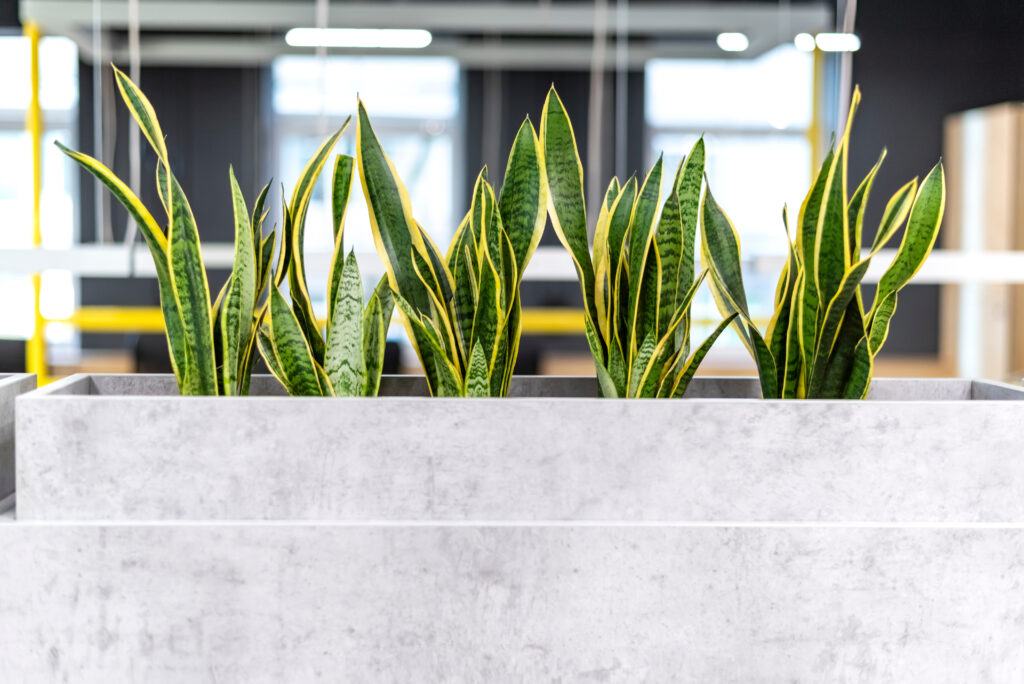
Snake Plant (Sansevieria)
Sansevieria, commonly known as the snake plant or mother-in-law's tongue, is a popular indoor plant with several notable characteristics and benefits:
- Low Maintenance: Sansevierias are renowned for their low-maintenance nature. They are forgiving of irregular watering and can tolerate periods of neglect. Overwatering is a common mistake, so it's best to let the soil dry out between waterings.
- Tolerant of Low Light: Snake plants can thrive in a wide range of lighting conditions, including low light. They can also tolerate bright, indirect sunlight. This adaptability makes them suitable for various indoor settings.
- Air Purification: Snake plants are excellent air purifiers. They are known for their ability to remove toxins such as formaldehyde and benzene from the air, making indoor air cleaner and healthier to breathe.
- Attractive Foliage: Sansevierias have striking, upright leaves that come in various shades of green and variegated patterns. Some common varieties include the classic green snake plant and the variegated snake plant with yellow or white stripes.
- Indoor Decor: The architectural shape and attractive foliage of snake plants make them a popular choice for interior decor. They can add a touch of greenery and style to any room.
- NASA's Clean Air Study: Snake plants were part of NASA's Clean Air Study, which aimed to find plants that could help improve indoor air quality in space stations. This study found that snake plants were effective at removing indoor air pollutants.
- Resilience: Sansevierias are resilient plants that can withstand fluctuations in temperature and humidity. They are less susceptible to pests and diseases compared to some other indoor plants.
- Propagation: Snake plants can be easily propagated through division or leaf cuttings. This makes it simple to create new plants from an existing one.
Care Tips:
- Light: They can tolerate low to bright, indirect light. Avoid direct sunlight, as it can scorch the leaves.
- Water: Allow the soil to dry out between waterings. Overwatering can lead to root rot. Water sparingly during the growing season (spring and summer) and reduce watering in the dormant season (fall and winter).
- Temperature: They prefer temperatures between 70-90°F (21-32°C) but can tolerate lower temperatures as long as they are not exposed to frost.
- Soil: Well-draining potting mix is essential to prevent waterlogging.
- Fertilizing: Fertilize sparingly during the growing season, typically once a month with a balanced liquid fertilizer.
Sansevierias are not only visually appealing but also contribute to a healthier indoor environment, making them a popular choice among both novice and experienced indoor plant enthusiasts.
Eliminates: CO2, benzene, formaldehyde, xylene, and toluene.
Toxic for humans and animals.
Find your Snake Plant here.
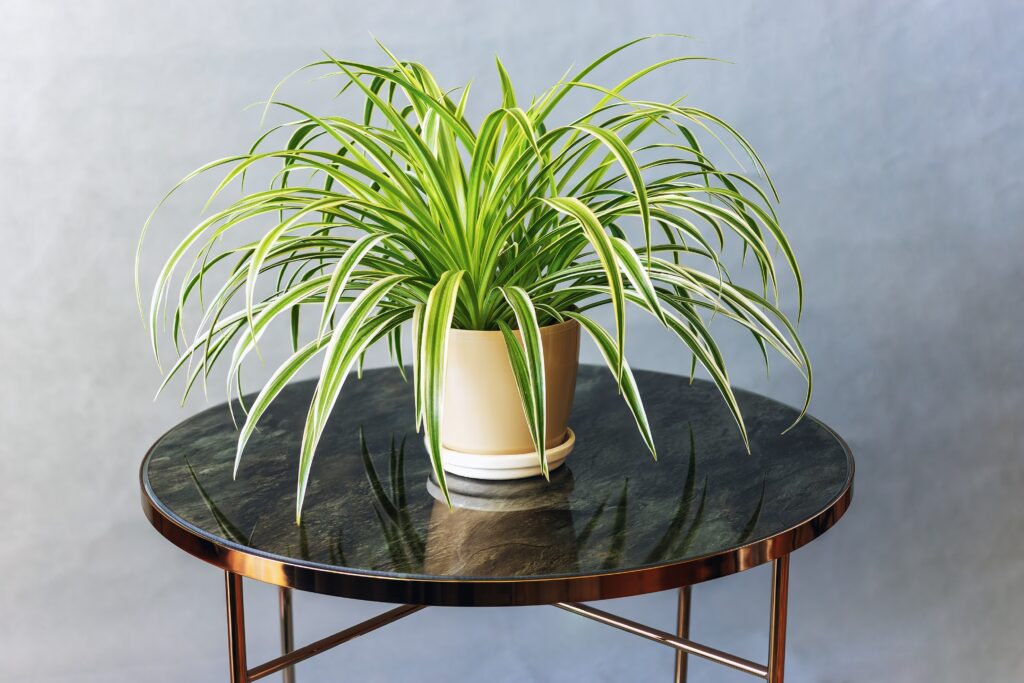
Spider Plant (Chlorophytum comosum)
The Spider Plant, scientifically known as Chlorophytum comosum, is a popular indoor plant known for its distinctive arching foliage and air-purifying properties. Here are some key features and care tips for spider plants:
- Air Purification: Spider plants are excellent air purifiers. They help remove pollutants such as formaldehyde and xylene from indoor air, making them a great choice for improving indoor air quality.
- Distinctive Foliage: Spider plants have long, arching leaves that are typically green with white stripes or variegation. The foliage grows in a rosette pattern, and some varieties produce small, white flowers followed by baby spider plantlets (offshoots) at the end of long stems.
- Adaptability: Spider plants are adaptable to a variety of indoor conditions. They can tolerate a range of light levels, from bright, indirect light to lower light conditions. However, they tend to thrive in moderate to bright indirect light.
- Low Maintenance: Spider plants are relatively low-maintenance and can tolerate occasional neglect. They are forgiving if you forget to water them occasionally.
- Easy Propagation: Spider plants are easy to propagate. The baby spider plantlets that form on long stems can be removed and potted separately to grow into new plants.
Care Tips:
- Light: Spider plants can adapt to different light conditions, but they prefer bright, indirect sunlight. Avoid direct sunlight, as it can scorch the leaves. They can also tolerate lower light conditions but may not produce as many offshoots or flowers in lower light.
- Water: Allow the top inch or two of the soil to dry out between waterings. Spider plants are sensitive to overwatering, so it's better to err on the side of underwatering. Reduce watering during the dormant winter months.
- Temperature: Spider plants prefer temperatures between 65-75°F (18-24°C) but can tolerate slightly cooler temperatures. Avoid exposing them to drafts or extreme temperature fluctuations.
- Soil: Use a well-draining potting mix to prevent waterlogged roots. Spider plants are not overly picky about soil type but do best in a mix designed for houseplants.
- Fertilizing: Feed your spider plant with a balanced liquid fertilizer diluted to half-strength during the growing season (spring and summer). Reduce or eliminate fertilization during the dormant season (fall and winter).
- Pruning: Remove any brown or yellowing leaves to maintain the plant's appearance and overall health.
- Propagation: To propagate spider plants, simply snip off the baby spiderettes when they are large enough, and pot them in their own containers with well-draining soil.
Spider plants are not only attractive and easy to care for but also provide the added benefit of improving indoor air quality. They are a popular choice for both beginner and experienced indoor gardeners and can thrive in a variety of indoor environments.
Eliminates: formaldehyde, xylene.
Non-toxic for children and animals.
Find your Spider Plant here.

Pothos (Epipremnum aureum)
Pothos, scientifically known as Epipremnum aureum but also commonly referred to as Devil's Ivy or Golden Pothos, is a popular and easy-to-care-for indoor plant. Here are some key features and care tips for pothos:
- Attractive Foliage: Pothos plants have heart-shaped leaves that are typically variegated with shades of green, yellow, or white. The variegation patterns can vary depending on the specific variety.
- Air Purification: Like many indoor plants, pothos is known for its air-purifying qualities. It can help remove indoor pollutants, making the air in your home cleaner and healthier.
- Versatile and Adaptable: Pothos is highly adaptable and can thrive in various indoor conditions. It can tolerate low to bright, indirect light and is suitable for homes or offices.
- Low Maintenance: Pothos is one of the easiest houseplants to care for, making it a great choice for beginners. It can withstand some neglect and doesn't require frequent watering.
- Trailing Growth Habit: Pothos plants have a trailing growth habit, making them well-suited for hanging baskets, shelves, or as a trailing accent in a pot.
Care Tips:
- Light: Pothos can tolerate a wide range of light conditions, but it thrives in bright, indirect light. It can also survive in low-light conditions but may grow more slowly and have less variegation in lower light.
- Water: Allow the top inch or so of the soil to dry out before watering. Pothos is susceptible to overwatering, so it's better to underwater than overwater. Reduce watering during the dormant winter months.
- Temperature: Pothos prefers temperatures between 65-75°F (18-24°C) and should be protected from drafts and temperature extremes.
- Soil: Use a well-draining potting mix, such as a standard indoor plant mix. Ensure the pot has drainage holes to prevent water from accumulating in the bottom.
- Fertilizing: Feed your pothos with a balanced liquid fertilizer diluted to half-strength every 2-4 weeks during the growing season (spring and summer). Reduce or eliminate fertilization during the dormant season (fall and winter).
- Pruning: Prune your pothos as needed to control its size and shape. This can also encourage bushier growth.
- Propagation: Pothos can be easily propagated by taking stem cuttings. Cut a section of stem with at least one node (the small bump where leaves and roots grow), place it in water until it develops roots, and then pot it in soil.
- Support: If you want your pothos to grow more upright, provide a support, such as a stake or trellis, for it to climb.
Pothos is a versatile and attractive houseplant that requires minimal care. It's an excellent choice for adding greenery to your indoor space, whether you're a seasoned plant enthusiast or new to indoor gardening. Its tolerance for varying light conditions and forgiving nature make it a popular choice among indoor plant enthusiasts.
Eliminates: formaldehyde, xylene, toluene, benzene, carbon monoxide, and more.
Toxic to animals.
Find your Pothos here.
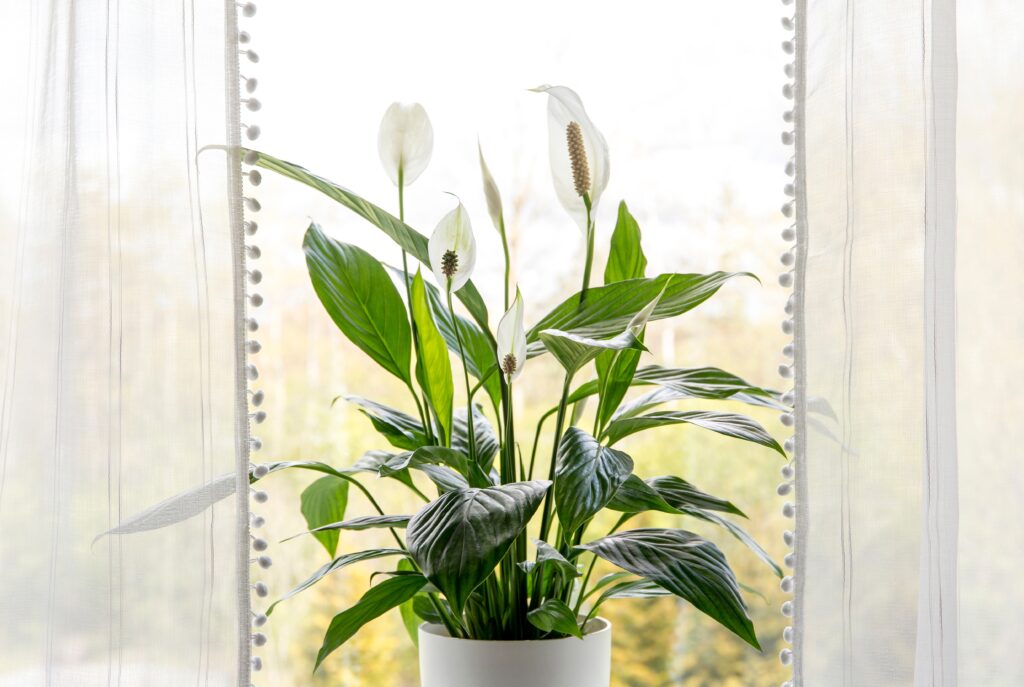
Peace Lily (Spathiphyllum)
The Peace Lily, scientifically known as Spathiphyllum, is a popular and elegant indoor plant known for its beautiful white flowers and air-purifying qualities. Here are some key features and care tips for Peace Lilies:
- Graceful Appearance: Peace Lilies are admired for their graceful, white, spoon-shaped flowers (spathes) that rise above glossy, dark green leaves. These flowers are often mistaken for petals but are actually modified leaves.
- Air Purification: Peace Lilies are excellent air purifiers. They can help remove common indoor pollutants like formaldehyde, benzene, and ammonia, making the air in your home healthier to breathe.
- Low Maintenance: While they may look delicate, Peace Lilies are relatively easy to care for and can tolerate some neglect. They are a good choice for those new to indoor gardening.
- Adaptability: Peace Lilies can thrive in various lighting conditions, from low to bright, indirect light. However, they tend to bloom more prolifically in brighter light.
Care Tips:
- Light: Peace Lilies can adapt to different light conditions but tend to do best in bright, indirect light. They can tolerate low light, but their growth may slow, and they may produce fewer flowers in such conditions.
- Water: Keep the soil consistently moist but not soggy. Water thoroughly when the top inch or so of the soil feels dry to the touch. Avoid letting the plant sit in standing water, as this can lead to root rot.
- Temperature: Peace Lilies prefer temperatures between 65-80°F (18-27°C). They are sensitive to cold drafts and should be protected from temperature extremes.
- Humidity: These plants appreciate higher humidity levels. You can increase humidity by misting the plant, placing it on a humidity tray filled with water and pebbles, or using a room humidifier.
- Soil: Use a well-draining potting mix that retains some moisture. A mix designed for indoor plants or a combination of peat-based potting mix and perlite works well.
- Fertilizing: Feed your Peace Lily with a balanced, water-soluble fertilizer diluted to half-strength every 6-8 weeks during the growing season (spring and summer). Reduce or eliminate fertilization during the dormant season (fall and winter).
- Pruning: Trim away any brown or yellowing leaves to maintain the plant's appearance and overall health. Remove faded flowers to encourage more blooming.
- Repotting: Peace Lilies typically don't require frequent repotting. Repot when the plant becomes root-bound, usually every 2-3 years.
- Toxicity: Keep in mind that Peace Lilies are toxic to pets and humans if ingested. Be cautious if you have pets or small children and keep the plant out of their reach.
- Propagation: You can propagate Peace Lilies by dividing the plant at the root level during repotting. Each division should have roots and a portion of the plant with leaves.
Peace Lilies are not only aesthetically pleasing but also contribute to better indoor air quality. Their elegant appearance and relatively low-maintenance care requirements make them a popular choice for homes and offices. With proper care, Peace Lilies can thrive and continue to produce their striking white blooms.
Eliminates: formaldehyde, benzene, trichloroethylene, xylene, ammonia, and more.
Toxic to animals and humans.
Find your Peace Lily here.
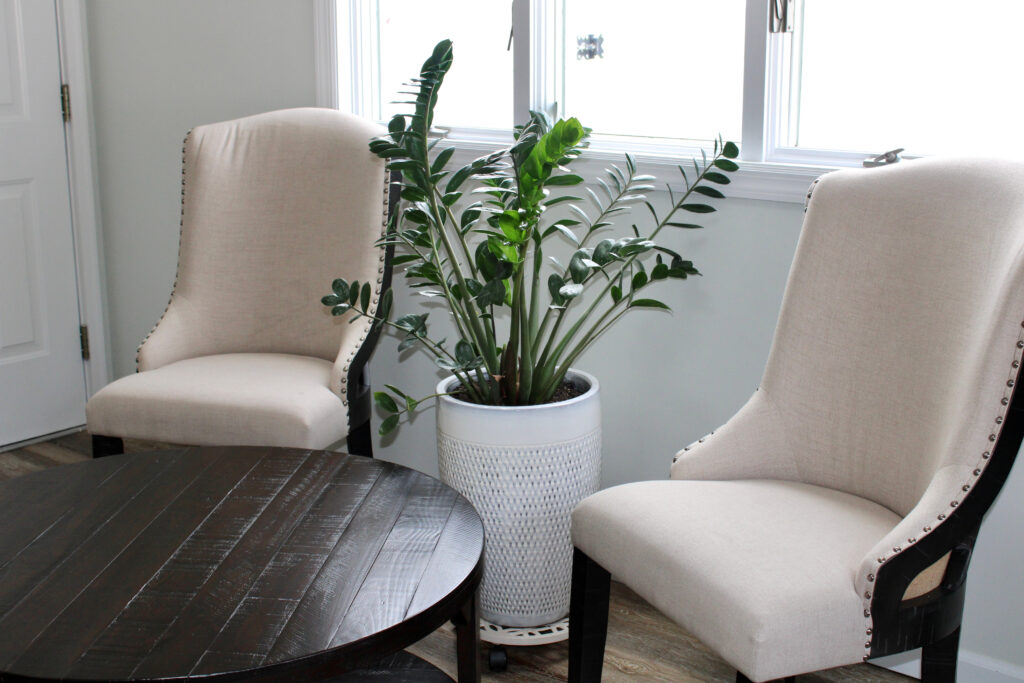
ZZ Plant (Zamioculcas zamiifolia)
The ZZ Plant, scientifically known as Zamioculcas zamiifolia, is a popular indoor plant known for its attractive, glossy green foliage and its ability to thrive in low-light conditions. Here are some key features and care tips for ZZ Plants:
- Attractive Foliage: ZZ Plants have unique, waxy, and oval-shaped leaflets that grow on long, arching stems. The leaves are dark green and have a shiny, glossy appearance, giving the plant a sleek and modern look.
- Tolerance for Low Light: One of the standout features of ZZ Plants is their remarkable ability to thrive in low-light conditions. They can tolerate areas with minimal natural light and are well-suited for offices or rooms with limited sunlight.
- Low Maintenance: ZZ Plants are incredibly low-maintenance and are known for their drought tolerance. They can go for extended periods without water, making them an excellent choice for forgetful or busy plant owners.
- Air Purification: While not as famous for air purification as some other plants, ZZ Plants can help improve indoor air quality by filtering out certain toxins.
Care Tips:
- Light: ZZ Plants can tolerate low to bright, indirect light, but they do best in bright, indirect light. However, they can adapt to low-light conditions, making them a versatile choice for various indoor spaces.
- Water: Allow the soil to dry out completely between waterings. ZZ Plants are susceptible to root rot if overwatered, so it's crucial to err on the side of underwatering. Water less frequently during the dormant winter months.
- Temperature: ZZ Plants prefer temperatures between 65-75°F (18-24°C). They can tolerate slightly cooler temperatures but should be protected from drafts and extreme cold.
- Soil: Use a well-draining potting mix, such as a cactus or succulent mix. Good drainage is essential to prevent waterlogged roots.
- Fertilizing: ZZ Plants don't require frequent fertilization. Feed them with a balanced, water-soluble fertilizer diluted to half-strength every 2-3 months during the growing season (spring and summer). Avoid over-fertilizing, as it can lead to mineral buildup in the soil.
- Pruning: Trim away any yellow or dead leaves to maintain the plant's appearance and overall health. ZZ Plants have slow growth, so pruning may not be required often.
- Repotting: ZZ Plants are slow growers and typically don't need repotting frequently. Repot when the plant becomes root-bound, which may occur every 2-3 years.
- Toxicity: Keep in mind that ZZ Plants are toxic if ingested by pets or humans. Be cautious and keep them out of reach of children and pets.
- Propagation: Propagating ZZ Plants can be done through leaf or stem cuttings. Allow the cuttings to callus for a day or two before planting them in a well-draining potting mix.
ZZ Plants are an excellent choice for those who want an attractive indoor plant that requires minimal care and can thrive in low-light environments. Their striking foliage and low maintenance make them a popular choice for both beginners and experienced indoor gardeners.
Eliminates: xylene, toluene and benzene.
Toxic to humans and animals.
Find your ZZ Plant here.
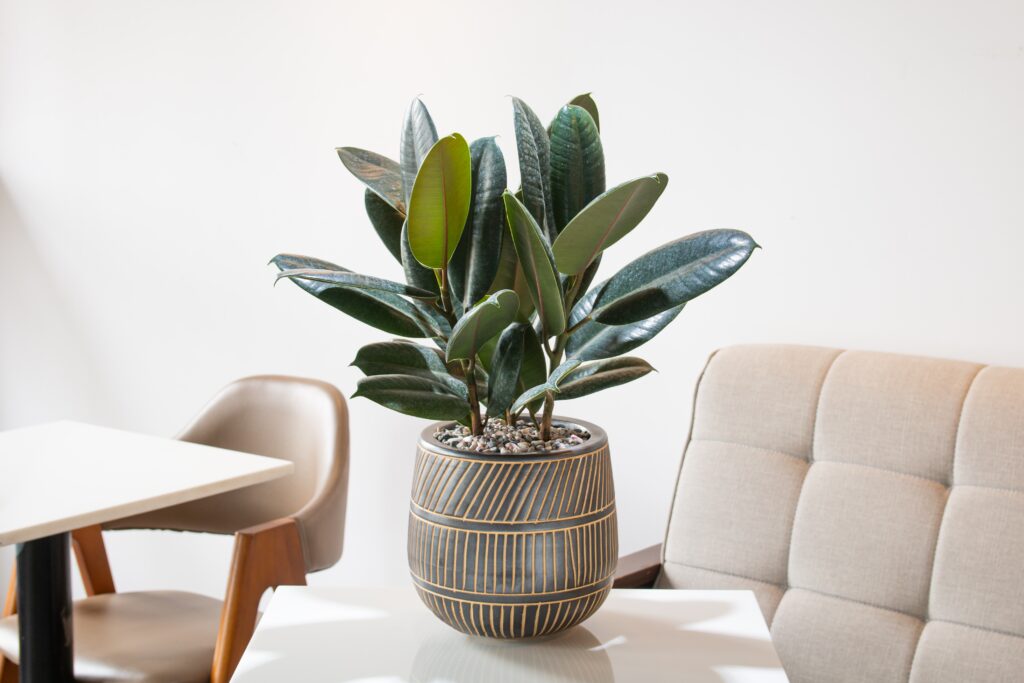
Rubber Plant (Ficus elastica)
The Rubber Plant, scientifically known as Ficus elastica, is a popular indoor plant with attractive, large, glossy leaves. Here are some key features and care tips for Rubber Plants:
- Large, Glossy Foliage: Rubber Plants have impressive, dark green, or variegated leaves that are typically thick, glossy, and elliptical in shape. These leaves add a touch of elegance to indoor spaces.
- Air Purification: Like many indoor plants, Rubber Plants have air-purifying qualities. They help remove indoor air pollutants, making the air in your home healthier to breathe.
- Adaptable to Different Light Levels: Rubber Plants can tolerate a range of light conditions, from moderate to bright, indirect light. They can adapt to various indoor environments.
- Indoor Decor: With their striking foliage and upright growth habit, Rubber Plants make excellent indoor decor and focal points in a room.
Care Tips:
- Light: Rubber Plants thrive in bright, indirect light. While they can tolerate lower light conditions, they may grow more slowly and become leggy in such conditions. Avoid exposing them to direct sunlight, as it can scorch their leaves.
- Water: Allow the top inch or so of the soil to dry out between waterings. Rubber Plants are sensitive to overwatering, so it's better to underwater than overwater. Reduce watering during the dormant winter months.
- Temperature: Rubber Plants prefer temperatures between 65-80°F (18-27°C). They should be protected from drafts and temperature extremes.
- Humidity: While they can adapt to average indoor humidity levels, Rubber Plants appreciate higher humidity. You can increase humidity by misting the plant, using a room humidifier, or placing a humidity tray nearby.
- Soil: Use a well-draining potting mix designed for houseplants. Ensure the pot has drainage holes to prevent waterlogged roots.
- Fertilizing: Feed your Rubber Plant with a balanced, water-soluble fertilizer diluted to half-strength every 2-4 weeks during the growing season (spring and summer). Reduce or eliminate fertilization during the dormant season (fall and winter).
- Pruning: Prune your Rubber Plant as needed to control its size and shape. Removing dead or yellowing leaves will help maintain its appearance.
- Repotting: Rubber Plants typically don't require frequent repotting. Repot when the plant becomes root-bound, which may occur every 2-3 years.
- Toxicity: Keep in mind that Rubber Plants are toxic to pets and humans if ingested. Be cautious if you have pets or small children and keep the plant out of their reach.
- Propagation: You can propagate Rubber Plants through stem cuttings. Take a cutting with at least one node (where leaves and roots grow) and plant it in a well-draining potting mix.
Rubber Plants are known for their elegant appearance and relatively low-maintenance care requirements, making them a popular choice for indoor plant enthusiasts. With proper care, they can thrive and continue to add beauty to your indoor space.
Eliminates: formaldehyde, mold spores and bacteria from the air (by up to 60%).
Toxic to animals.
Find your Rubber Plant here.
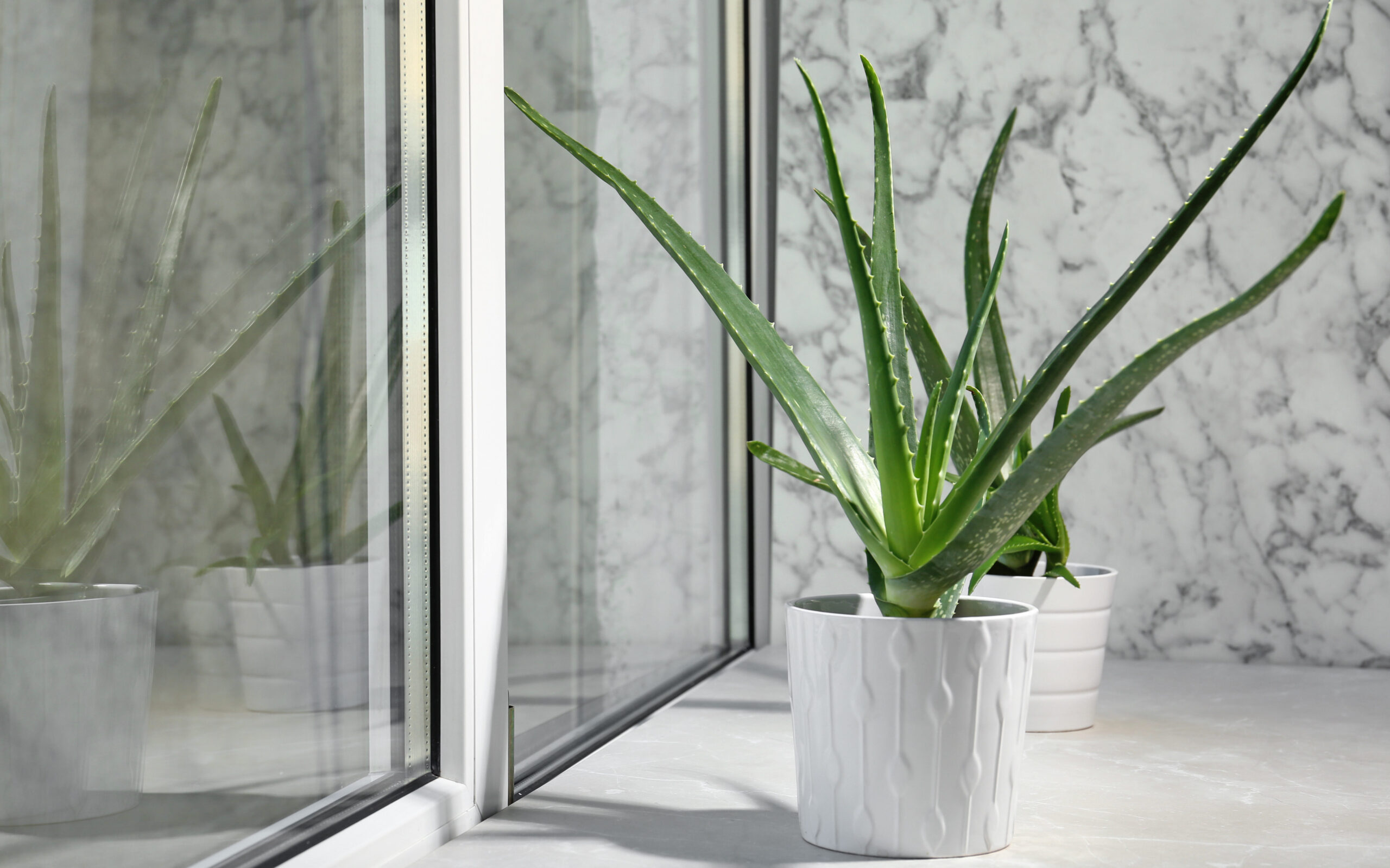
Aloe Vera
Aloe vera is a versatile and popular succulent known for its soothing gel-filled leaves and numerous medicinal and cosmetic uses. Here are some key features and care tips for Aloe vera plants:
- Succulent Leaves: Aloe vera has fleshy, lance-shaped leaves that are typically green, although they can have a slight bluish tint. The leaves are filled with a clear, soothing gel that is well-known for its various health benefits.
- Medicinal Uses: Aloe vera gel is commonly used to soothe minor skin irritations, burns, and sunburns. It has anti-inflammatory and healing properties and is found in many skincare and cosmetic products.
- Air Purification: Like many indoor plants, Aloe vera helps improve indoor air quality by absorbing airborne toxins such as formaldehyde and benzene.
- Low Maintenance: Aloe vera is relatively low-maintenance and can thrive with minimal care. It is a hardy and drought-tolerant plant.
Care Tips:
- Light: Aloe vera plants prefer bright, indirect sunlight. They can tolerate some direct sunlight, but too much direct sun can cause their leaves to become sunburned.
- Water: Allow the soil to dry out completely between waterings. Aloe vera is susceptible to root rot if overwatered, so it's best to err on the side of underwatering. Water less frequently during the dormant winter months.
- Temperature: Aloe vera prefers temperatures between 59-77°F (15-25°C). It can tolerate slightly cooler temperatures but should be protected from frost.
- Soil: Plant Aloe vera in a well-draining potting mix designed for succulents or cacti. Good drainage is essential to prevent waterlogged roots.
- Container: Use a pot with drainage holes to allow excess water to escape. Aloe vera is often grown in shallow containers due to its shallow root system.
- Fertilizing: Aloe vera is not a heavy feeder and doesn't require frequent fertilization. You can feed it with a diluted, balanced liquid fertilizer every 2-4 months during the growing season (spring and summer). Avoid over-fertilizing.
- Pruning: Prune Aloe vera as needed to remove dead or damaged leaves. This will help maintain its appearance and overall health.
- Pot Size: Repot Aloe vera when it becomes root-bound, typically every 2-3 years. Choose a slightly larger pot with good drainage when repotting.
- Toxicity: While the gel from Aloe vera leaves is known for its medicinal uses, the yellowish sap found just beneath the leaf's skin can be mildly toxic if ingested. Keep it out of reach of pets and children.
Aloe vera is a versatile and attractive indoor plant that not only adds a touch of greenery to your home but also offers natural remedies for minor skin irritations and burns. With proper care, your Aloe vera plant can thrive and provide you with its soothing gel when needed.
Eliminates: carbon dioxide.
Aloe latex or whole-leaf extract is toxic to humans and animals.
Find your Aloe Vera here.
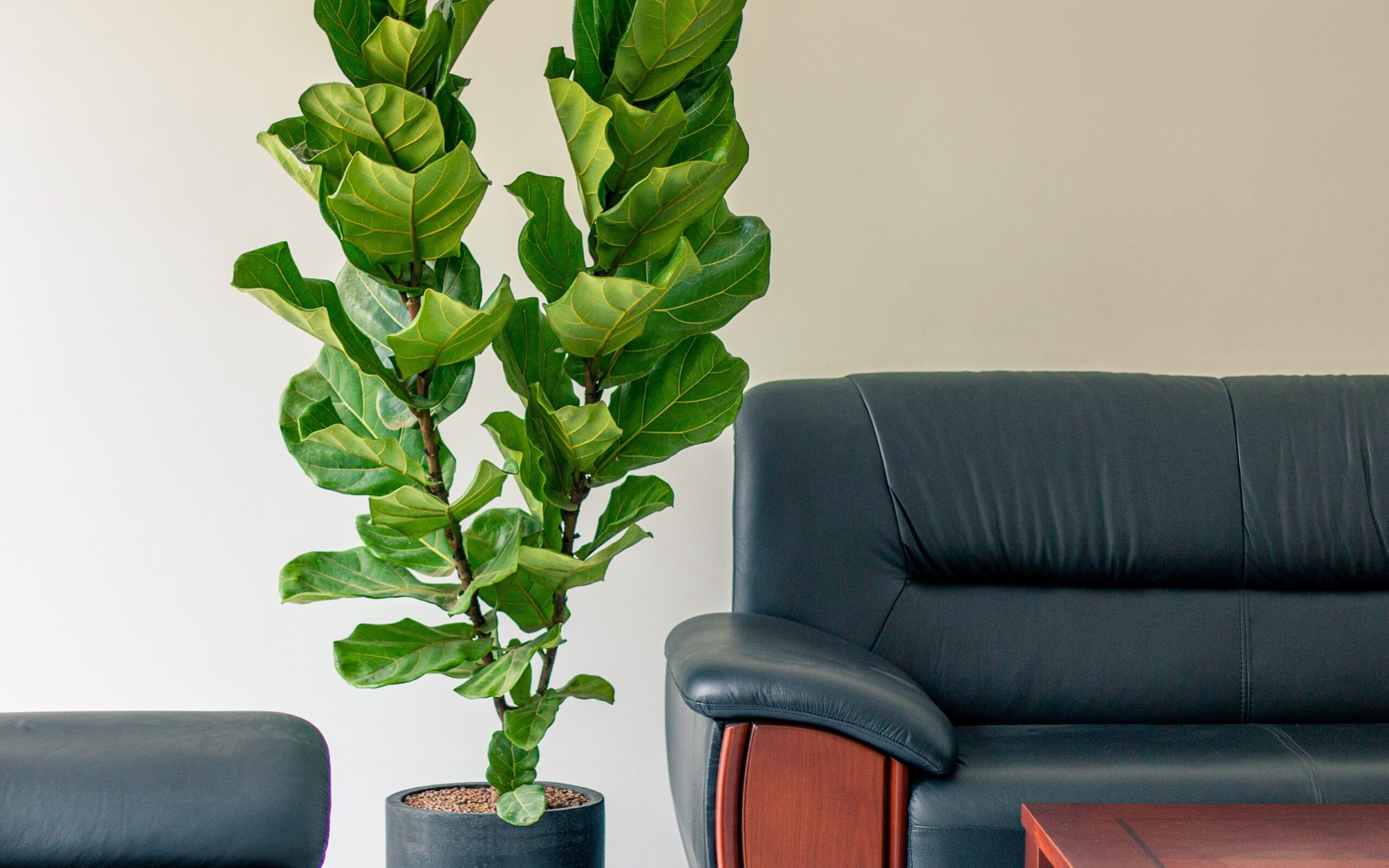
Fiddle Leaf Fig (Ficus lyrata)
The Fiddle Leaf Fig, scientifically known as Ficus lyrata, is a popular indoor plant known for its large, distinctive, violin-shaped leaves. Here are some key features and care tips for Fiddle Leaf Fig plants:
- Large, Fiddle-Shaped Leaves: Fiddle Leaf Figs have large, glossy leaves that are shaped like violins, hence their name. These leaves give the plant an elegant and tropical appearance.
- Interior Decor: Due to their striking foliage and impressive size, Fiddle Leaf Figs are often used as statement pieces in interior decor, adding a touch of drama and greenery to homes and offices.
- Air-Purifying: Like many indoor plants, Fiddle Leaf Figs help improve indoor air quality by filtering out pollutants and toxins from the air.
- Moderate Growth: These plants have moderate growth and can become tall and tree-like over time if given the proper care.
Care Tips:
- Light: Fiddle Leaf Figs thrive in bright, indirect light. They require plenty of indirect sunlight to grow and develop their large leaves. Avoid exposing them to direct sunlight, which can lead to leaf burn.
- Water: Allow the top 1-2 inches of the soil to dry out between waterings. Water thoroughly when you do water the plant, but avoid letting it sit in standing water. Overwatering can lead to root rot, so it's crucial not to water too frequently.
- Temperature: Fiddle Leaf Figs prefer temperatures between 65-75°F (18-24°C) and are sensitive to temperature fluctuations and cold drafts. Protect them from extreme temperature changes.
- Humidity: These plants appreciate higher humidity levels. You can increase humidity by misting the plant, using a room humidifier, or placing a humidity tray nearby.
- Soil: Use a well-draining potting mix that is suitable for indoor plants. Adding some perlite or orchid bark can help improve drainage.
- Fertilizing: Feed your Fiddle Leaf Fig with a balanced liquid fertilizer diluted to half-strength every 4-6 weeks during the growing season (spring and summer). Reduce or eliminate fertilization during the dormant season (fall and winter).
- Pruning: Prune your Fiddle Leaf Fig as needed to maintain its shape and size. Removing dead or yellowing leaves will help the plant look healthy and vibrant.
- Support: As Fiddle Leaf Figs grow taller, they may benefit from a stake or support to prevent them from becoming top-heavy and leaning.
- Repotting: These plants generally don't need frequent repotting. Repot when the plant becomes root-bound, which may occur every 2-3 years.
- Toxicity: Keep in mind that Fiddle Leaf Figs are toxic if ingested by pets or humans. Be cautious if you have pets or small children and keep the plant out of their reach.
Fiddle Leaf Figs are known for their stunning appearance and can be a rewarding addition to your indoor plant collection. With the right care and attention to their specific needs, they can thrive and become a focal point in your interior decor.
Eliminates: toxins.
Toxic to humans and animals.
Find your Fiddle Leaf Fig here.
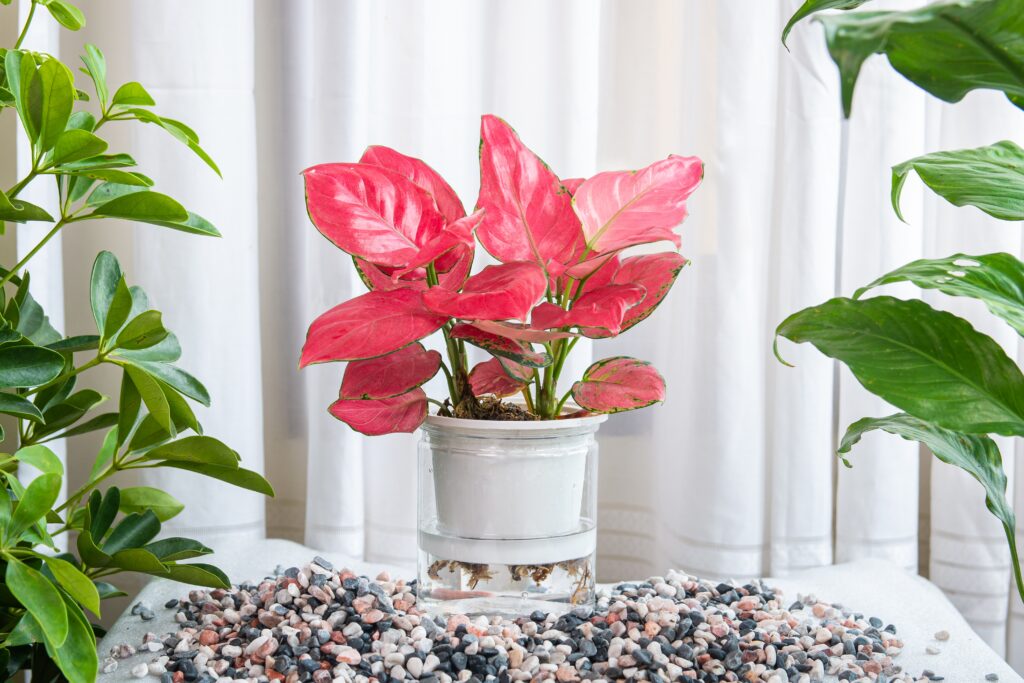
Chinese Evergreen (Aglaonema)
The Chinese Evergreen, scientifically known as Aglaonema, is a popular and versatile indoor plant known for its attractive foliage and low-maintenance care requirements. Here are some key features and care tips for Chinese Evergreen plants:
- Varied Foliage: Chinese Evergreen plants come in various cultivars, each with its unique foliage patterns and colors. Common variations include shades of green, silver, red, and pink, often with striking patterns and variegation.
- Air Purification: Like many indoor plants, Chinese Evergreens are effective air purifiers. They can help remove indoor air pollutants such as formaldehyde and benzene, making the air in your home cleaner.
- Adaptability: Chinese Evergreens are known for their adaptability to different indoor conditions. They can tolerate low to moderate light and are suitable for various rooms in your home or office.
- Low Maintenance: These plants are relatively low-maintenance and are forgiving of occasional neglect. They are a good choice for beginners and for those who may not have a green thumb.
Care Tips:
- Light: Chinese Evergreens can adapt to various lighting conditions, but they thrive in bright, indirect light. They can tolerate lower light levels but may grow more slowly and have less vibrant foliage in such conditions.
- Water: Allow the top inch or two of the soil to dry out between waterings. Chinese Evergreens are susceptible to root rot if overwatered, so it's essential not to let them sit in standing water. Reduce watering during the dormant winter months.
- Temperature: Chinese Evergreens prefer temperatures between 65-80°F (18-27°C). They should be protected from drafts and temperature extremes.
- Humidity: While they can adapt to average indoor humidity levels, Chinese Evergreens appreciate higher humidity. You can increase humidity by misting the plant, using a room humidifier, or placing a humidity tray nearby.
- Soil: Use a well-draining potting mix designed for indoor plants. Good drainage is essential to prevent waterlogged roots.
- Fertilizing: Feed your Chinese Evergreen with a balanced, water-soluble fertilizer diluted to half-strength every 4-6 weeks during the growing season (spring and summer). Reduce or eliminate fertilization during the dormant season (fall and winter).
- Pruning: Prune your Chinese Evergreen as needed to maintain its shape and size. Remove any dead or yellowing leaves to promote healthy growth.
- Repotting: Chinese Evergreens typically don't need frequent repotting. Repot when the plant becomes root-bound, which may occur every 2-3 years.
- Toxicity: Keep in mind that Chinese Evergreens are toxic if ingested by pets or humans. Be cautious if you have pets or small children and keep the plant out of their reach.
Chinese Evergreens are known for their beauty and adaptability, making them an excellent choice for adding vibrant foliage to your indoor space. With proper care, they can thrive and brighten up your home or office year-round.
Eliminates: benzene, carbon monoxide, formaldehyde, trichloroethylene, and more.
Toxic to animals.
Find your Chinese Evergreen here.
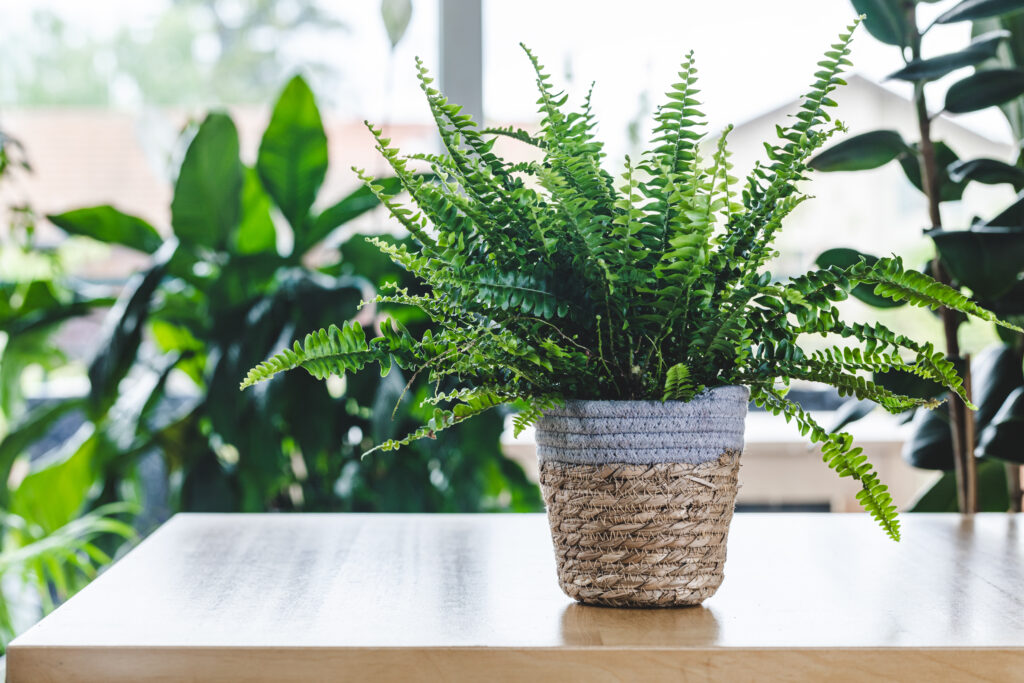
Boston Fern (Nephrolepis exaltata)
The Boston Fern, scientifically known as Nephrolepis exaltata, is a classic and popular indoor fern with feathery, delicate fronds. Here are some key features and care tips for Boston Ferns:
- Elegant Fronds: Boston Ferns are appreciated for their lush, arching fronds that give them a graceful, cascading appearance. The feathery foliage adds a touch of elegance to indoor spaces.
- Air Purification: Like many indoor plants, Boston Ferns help improve indoor air quality by filtering out pollutants and adding humidity to the air.
- Bright Green Foliage: These ferns typically have bright green, finely divided fronds that create a vibrant and lively atmosphere in your home.
- Moderate Growth: Boston Ferns have moderate growth and can grow to a considerable size over time, making them an attractive and striking addition to your indoor garden.
Care Tips:
- Light: Boston Ferns prefer bright, indirect light. They can tolerate some morning or filtered sunlight but should be protected from direct sun, which can scorch their fronds. Inadequate light can lead to sparse growth.
- Water: Keep the soil consistently moist but not waterlogged. Water when the top inch of soil feels dry to the touch. Provide a humid environment by misting the fronds regularly or placing the pot on a humidity tray.
- Temperature: Boston Ferns thrive in temperatures between 65-75°F (18-24°C). They are sensitive to drafts and temperature fluctuations, so avoid placing them near heating or cooling vents.
- Humidity: These ferns require higher humidity levels to thrive. In drier indoor environments, you can maintain humidity by misting the plant, using a room humidifier, or placing a tray of water and pebbles near the plant.
- Soil: Use a well-draining potting mix that retains some moisture. A mix formulated for ferns or indoor plants works well.
- Fertilizing: Feed your Boston Fern with a balanced, water-soluble fertilizer diluted to half-strength every 4-6 weeks during the growing season (spring and summer). Reduce or eliminate fertilization during the dormant season (fall and winter).
- Pruning: Prune your Boston Fern as needed to remove dead or yellowing fronds and maintain its shape. This will encourage healthy growth and prevent overcrowding.
- Repotting: Boston Ferns generally don't need frequent repotting. Repot when the plant becomes root-bound, which may occur every 2-3 years.
- Toxicity: Boston Ferns are non-toxic and safe for pets and humans. They are a pet-friendly option if you have cats or dogs in your home.
Boston Ferns are known for their elegance and lush foliage, making them a wonderful choice for adding a touch of greenery to your indoor space. With proper care and attention to their specific needs, they can thrive and enhance the ambiance of your home.
Eliminates: toluene.
Not toxic to animals.
Find your Boston Fern here.
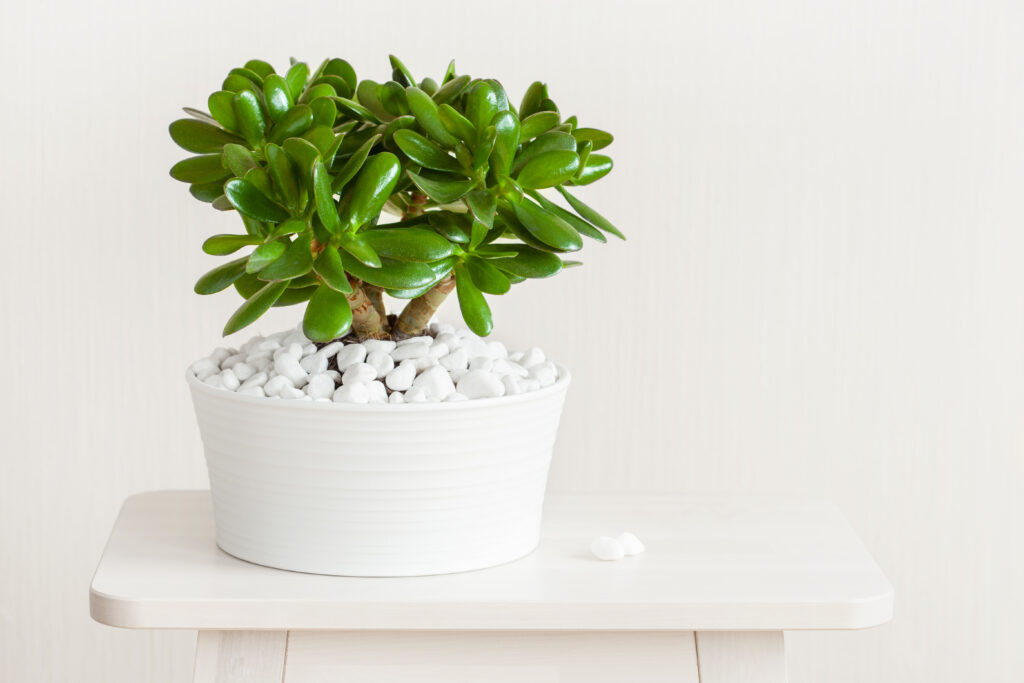
Jade Plant (Crassula ovata)
The Jade Plant, scientifically known as Crassula ovata, is a popular succulent known for its distinctive appearance and ease of care. Here are some key features and care tips for Jade Plants:
- Succulent Appearance: Jade Plants have thick, fleshy leaves that are typically oval or rounded, with a glossy, jade-green color. They give the plant a unique and appealing appearance.
- Indoor Decor: Jade Plants are often used as indoor decor due to their charming appearance and symbolic value. They are believed to bring good luck and prosperity, making them popular housewarming gifts.
- Drought Tolerance: These succulents are incredibly drought-tolerant and can store water in their leaves. This adaptation allows them to withstand periods of neglect and infrequent watering.
- Slow Growth: Jade Plants have a slow growth rate and can develop into small trees with age if provided with the right care and growing conditions.
Care Tips:
- Light: Jade Plants thrive in bright, indirect light. They can tolerate some direct sunlight, but excessive sun exposure can lead to sunburn, especially for young plants. Rotate the plant occasionally to ensure even growth.
- Water: Allow the top inch or two of the soil to dry out completely between waterings. Water sparingly and thoroughly, and be cautious not to overwater, as succulents are susceptible to root rot. Reduce watering during the dormant winter months.
- Temperature: Jade Plants prefer temperatures between 65-75°F (18-24°C). They can tolerate slightly cooler temperatures but should be protected from frost.
- Humidity: These succulents can adapt to average indoor humidity levels, but they may benefit from slightly higher humidity. However, maintaining moderate humidity is usually sufficient.
- Soil: Plant Jade Plants in a well-draining succulent or cactus potting mix. Good drainage is essential to prevent waterlogged roots.
- Fertilizing: Feed your Jade Plant with a balanced, water-soluble fertilizer diluted to half-strength every 2-3 months during the growing season (spring and summer). Avoid over-fertilizing.
- Pruning: Prune your Jade Plant as needed to maintain its shape and size. Remove any dead or yellowing leaves to promote healthy growth.
- Repotting: Jade Plants typically don't require frequent repotting. Repot when the plant becomes root-bound, which may occur every 2-3 years.
- Toxicity: Keep in mind that Jade Plants are toxic to pets if ingested. Be cautious if you have pets and keep the plant out of their reach.
Jade Plants are not only visually appealing but also relatively low-maintenance, making them an excellent choice for both novice and experienced indoor plant enthusiasts. With proper care, they can thrive and bring a touch of nature to your indoor space while symbolizing good fortune and prosperity.
Eliminates: VOCs from the air.
Toxic to animals.
Find your Jade Plant here.
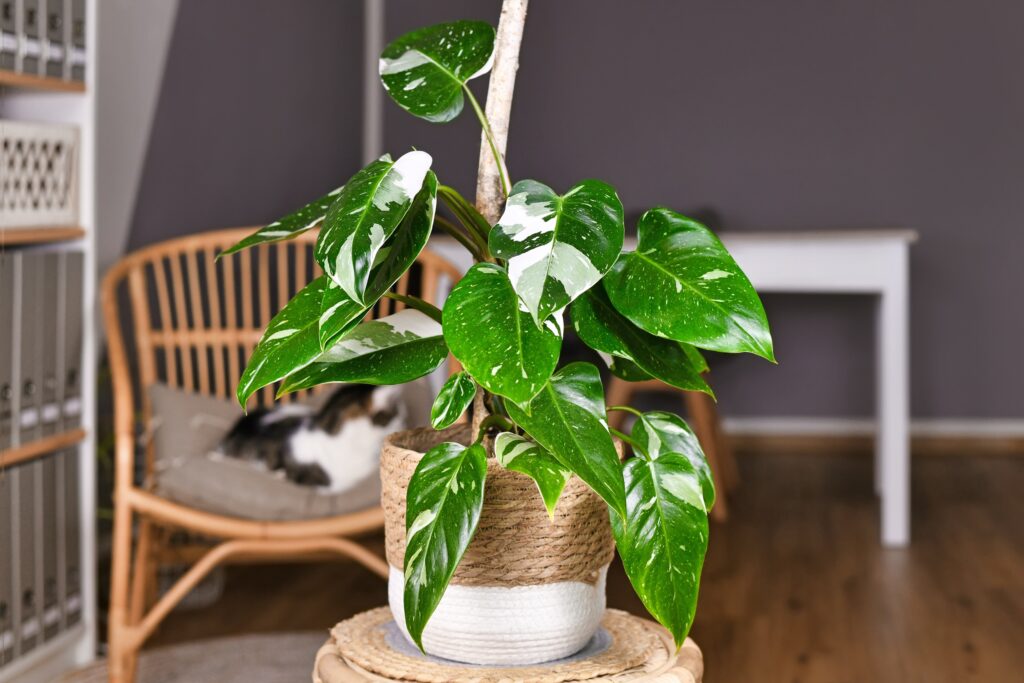
Philodendron
Philodendrons are a diverse and popular group of indoor and outdoor plants known for their attractive foliage and ease of care. There are many different species and varieties within the Philodendron genus, but they share some common care guidelines. Here are some key features and care tips for Philodendron plants:
- Attractive Foliage: Philodendrons are admired for their lush and often heart-shaped leaves. The foliage can vary in color, size, and shape, depending on the specific variety.
- Versatility: These plants come in various sizes, making them suitable for a range of indoor and outdoor spaces. They can be grown as trailing vines, climbers, or bushy floor plants.
- Air Purification: Philodendrons are effective at purifying indoor air by filtering out toxins and pollutants, helping to create a healthier indoor environment.
- Low Maintenance: Philodendrons are relatively low-maintenance and can tolerate some neglect. They are a good choice for beginners and for those who may not have a green thumb.
Care Tips:
- Light: Philodendrons thrive in bright, indirect light. While they can adapt to lower light conditions, they may not grow as vigorously or produce as much variegation in low light. Avoid direct sunlight, which can scorch their leaves.
- Water: Allow the top inch or so of the soil to dry out between waterings. Philodendrons prefer to be kept evenly moist but not waterlogged. Water less frequently during the dormant winter months.
- Temperature: Philodendrons prefer temperatures between 65-80°F (18-27°C). They can tolerate slightly cooler temperatures but should be protected from drafts and cold snaps.
- Humidity: These plants appreciate moderate to high humidity levels. If your indoor air is dry, you can increase humidity by misting the plant, using a room humidifier, or placing a humidity tray nearby.
- Soil: Use a well-draining potting mix that is designed for houseplants. Good drainage is essential to prevent waterlogged roots.
- Fertilizing: Feed your Philodendron with a balanced, water-soluble fertilizer diluted to half-strength every 4-6 weeks during the growing season (spring and summer). Reduce or eliminate fertilization during the dormant season (fall and winter).
- Pruning: Prune your Philodendron as needed to maintain its shape and size. Removing dead or yellowing leaves will help the plant look healthy and vibrant.
- Repotting: Philodendrons typically don't require frequent repotting. Repot when the plant becomes root-bound, which may occur every 2-3 years.
- Toxicity: Keep in mind that Philodendrons are toxic if ingested by pets or humans. Be cautious if you have pets or small children and keep the plant out of their reach.
Overall, Philodendrons are versatile and attractive indoor plants that can enhance the beauty of your living space while improving indoor air quality. With proper care and attention to their specific needs, they can thrive and become a charming addition to your indoor garden.
Eliminates: formaldehyde and other harmful chemicals from the air.
Toxic to animals.
Find your Philodendron here.
These are just a few examples of common indoor plants. When selecting indoor plants, consider the specific environmental conditions in your home or office, such as lighting and humidity and be mindful of each plant's care requirements to help them grow and flourish.
Many of these plants can be toxic to pets. Ask the staff at your local greenhouse about pet-safe and allergy-safe options. You can also look up which plants are toxic to animals on the ASPCA Toxic and Non-Toxic Plants page.
References:
https://www.piedmont.org/living-better/health-benefits-of-indoor-plants
https://www.healthline.com/health/air-purifying-plants#benefits-of-plants
https://www.ncbi.nlm.nih.gov/pmc/articles/PMC4419447/
https://www.washingtonpost.com/wellness/2022/06/06/how-houseplants-can-boost-your-mood/
https://www.aspca.org/pet-care/animal-poison-control/toxic-and-non-toxic-plants
